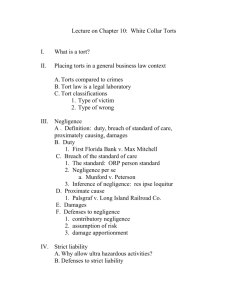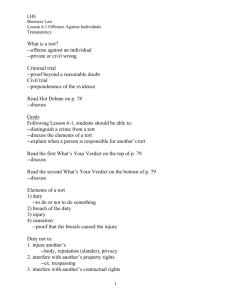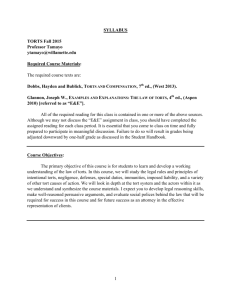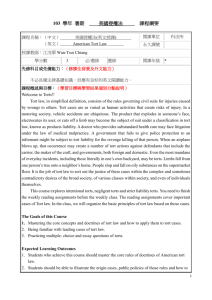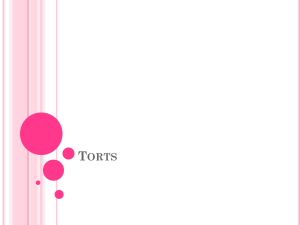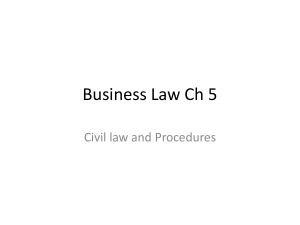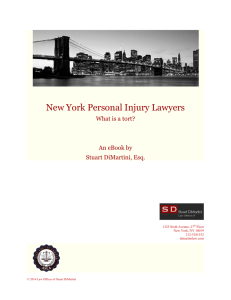Chapter 6: Personal Injury Laws
advertisement
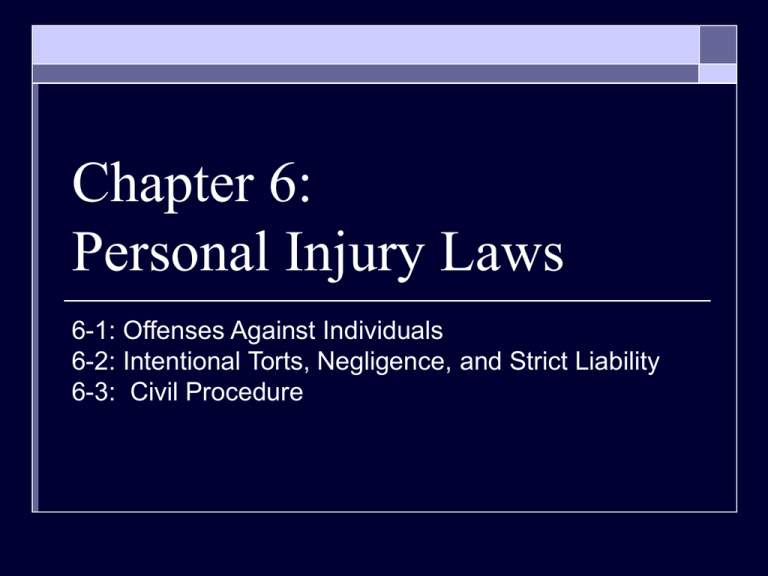
Chapter 6: Personal Injury Laws 6-1: Offenses Against Individuals 6-2: Intentional Torts, Negligence, and Strict Liability 6-3: Civil Procedure 6-1: Offenses Against Individuals Goals: Distinguish between a crime from a tort Discuss the elements of a tort Explain when a person is responsible for another’s tort What is a tort? Goal 1: Distinguish between a crime from a tort Difference Between Crimes and Torts Crime *Offense against society *Public wrong Tort *Offense against individual *Injured party can sue and obtain judgement for monetary damages What’s Your Verdict? Pg. 89 Did Josephina commit a crime or tort or both? Reckless driving caused Josephina to be liable both criminally and civilly Crime -Reckless driving Tort -Injured John and his property Goal 2: Discuss the elements of a tort Elements of a Tort Duty Breach Injury Causation Duty Not to injure another Not to interfere with property rights of others ex. bodily injury, injury to someone’s reputation, invasion of privacy ex. trespassing Not to interfere with economic rights of others ex. right to contract Violation of Duty Must be proved before injured party can collect damages Can be intentional or unintentional Can be based on negligence Injury Must be present-- If you act carelessly, but no one is injured, no tort! Causation Breach of duty caused injury Degrees of causation PROXIMATE CAUSE Goal 3: Explain when a person is responsible for another’s tort Responsibility for the Torts of Another Vicarious Liability Review 6-1 Worksheet 6-2: Intentional Torts, Negligence, and Strict Liability Goals: Identify nine common intentional torts Define negligence and strict liability What is an intentional tort? Goal 4: Identify nine common intentional torts 9 Common Intentional Torts Assault Battery False Imprisonment Defamation Invasion of Privacy Trespass to Land Conversion Interference with Contractual Relations Fraud Assault Threat to physically or offensively injure another Threat can be made with words or gestures Threat must be believable (there must be ability to carry out) Battery Harmful or offensive touching of another Shooting, pushing in anger, spitting on, etc. Frequently present after assault Angrily raising a fist (assault) then punching someone (battery) False Imprisonment Depriving a person of freedom of movement without the person’s consent and without privilege Privilege=police Defamation False statement that injures reputation Spoken=Slander Written=Libel Needs to: Be false Be communicated to 3rd party Bring victim into disrepute, contempt or ridicule by others Invasion of Privacy Unlawful and unwelcome intrusion into one’s private life so as to cause outrage, mental suffering, or humiliation Trespass to Land Entry onto the property of another without the owner’s consent May consist of other forms of interference with the possession of property Dumping garbage on someone’s land Breaking window’s of neighbor’s house Conversion Using property inconsistently with owner’s rights Converters=theives Interference With Contractual Relations Enticing or encouraging someone to break a contract Fraud Intentional misrepresentation of an existing important fact---A LIE! A misstatement is generally not fraudulent— intent is important Goal 5: Define negligence and strict liability Other Torts Negligence Most common tort Intent not a requirement (only carelessness) Involves breach of duty, causation, and injury Duty and Negligence Reasonable-person standard Violation of duty must be the proximate cause of injury Defenses to Negligence Contributory negligence Comparative negligence Assumption of risk Strict Liability Liability that exists even though defendant was not negligent Proof of activity and injury substitutes for proof of a violation of duty Ex.=target practice, blasting, crop dusting storing flammable liquids in large quantities, ownership of dangerous animals Sale of goods that are unreasonably dangerous (defective merchandise) 6-2 Review Worksheet 6-3: Civil Procedure Goals: Discuss what damages are available to victims of torts Explain the various stages of a civil suit Goal 6: Discuss what damages are available to victims of torts What Can A Tort Victim Collect?? What are damages? Monetary award to compensate for loss Actual or Compensatory Damages Purpose s to place the injured party in same financial position as if tort had not occurred What other methods can be used to “pay” damages other than money? Damages Compensatory Punitive Goal 7: Explain the various stages of a civil suit Civil Case Trials Judges and Juries Not always a right to a jury No jury=judge decides If a jury is present—6-12 members Plaintiff Defendant Civil Case Proceedings Opening Statements Presentation of Evidence Testimony by witnesses Articles of evidence Closing Arguments Jury Instructions Jury Deliberation Verdict Judgement Satisfying a Judgment Defendant pays If not, writ of execution can be filed Review 6-3 Worksheet A Civil Action…

